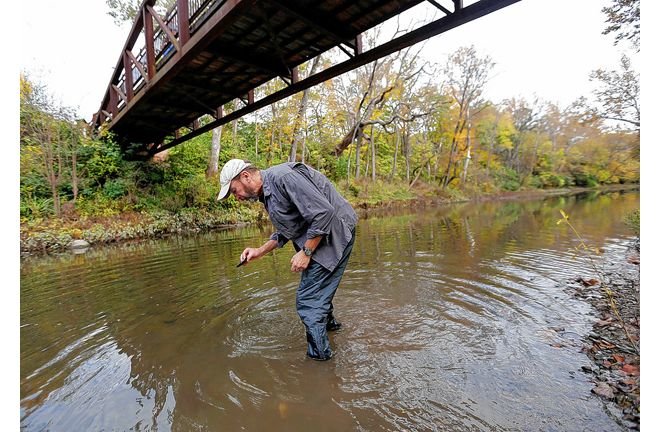
Biologists, mollusk experts and officials with state and federal agencies gathered Oct. 20 to talk about the mysterious die-off. They've been surveying the stream and collecting samples, but say it could be weeks before a cause is pinpointed.
In the meantime, the mollusks continue to die, leaving their empty shells strewn along the stream.
"This is one of the few last healthy rivers in America. If we lose that we're losing a key piece of our heritage," said John Tetzloff, president of the Darby Creek Association. "Mussels have been in decline for decades. ... It was a recipe for disaster and this is the disaster. This could be the end of Darby as we know it."
Mussels are immobile filter-feeders and are highly sensitive to environmental changes. That makes them "canaries in the coal mine" for various ecosystems tied to the Darby, Tetzloff said.
"When you start to see mussel die-offs, you might not see other impacts," he said, "but they're just the first one."
Burrowed into the stream bed and sealed as tight as drums, mussels are among the hidden aquatic wildlife. But dozens and dozens of dying or dead mussels have surfaced along miles of the Darby since early October, said Anthony Sasson, freshwater conservation manager for the Nature Conservancy in Ohio.
At least two federally endangered mussel species, the clubshell and northern riffleshell, have been affected, said Jo Ann Banda of the U.S. Fish and Wildlife Service.
"We don't know what the issue is," Banda said. "We really don't know what's happening."
In other words, no one knows if it is disease, a spill of some sort or diminishing overall water quality.
"It's still a mystery at this point," said John Watts, a resource manager with Metro Parks.
This week, Sasson waded in the creek and found dead mussels with every step.
"I believe they're still dying," Banda said, adding that she has not witnessed similar mussel die-offs since she joined the agency in 2010. "It's unusual."
A major hit to the 44 recorded mussel species in Darby Creek could undo decades of conservation efforts.
The Big Darby, which empties into the Scioto River in Pickaway County, is a designated National Scenic River and considered one of the most biodiverse streams in the region, according to the Nature Conservancy. The creek is protected by state regulations and numerous local ordinances.
"If this hits the rare species, then that's one more thing against them," Sasson said.
Tom Watters, a mollusk curator at Ohio State University, said die-offs such as this are rare.
In July 2000, an agribusiness spilled 20,000 gallons of fermented grain, molasses and other substances into the upper Big Darby Creek, killing 24,000 fish. In the mid-1980s, 89,000 animals were killed following an ammonia and liquid fertilizer spill by a Mechanicsburg agribusiness.
Though endangered mussel populations have declined in recent state history, efforts in the past decade have helped reintroduce them in some waterways, Watters said. Biologists recently transplanted federally endangered mussel species into the Darby, including thousands of riffleshells from the Allegheny River in western Pennsylvania.
Tetzloff said he hasn't had the heart to survey the damage.
"There are not rivers around the world that have 44 species of mussels in it," he said. " Tropical countries have their rain forests. Australia has its coral reefs. The United States has its warm-water streams."



Mussels crawl like snails, when the want or need to. Aside from that, this is indeed a tragedy and the cause MUST be found. Mussel beds in West Tn don't have to worry about pollutants taking them out. Wildlife 'Officials' preach about the importance of Mussel preservation, but routinely drain canals and some wild waterways, killing entire Mussel beds. Fortunately, raccoons quickly clean up all the evidence except for the abundance of empty shells.